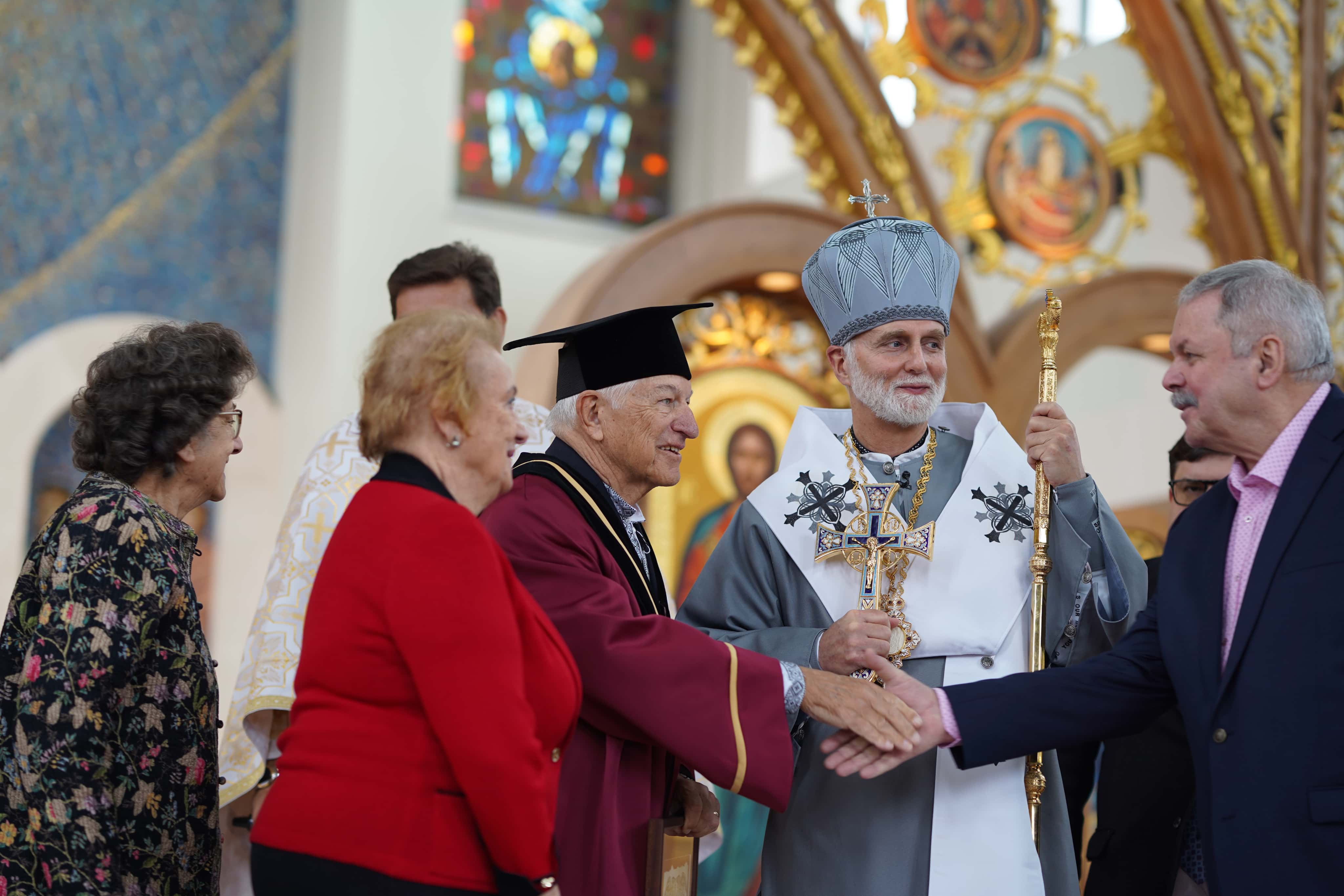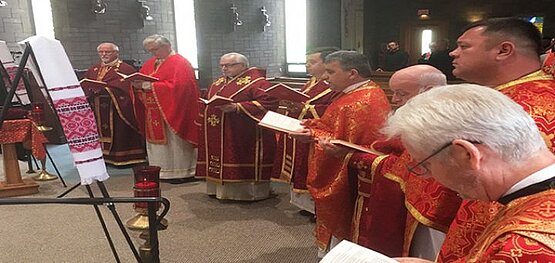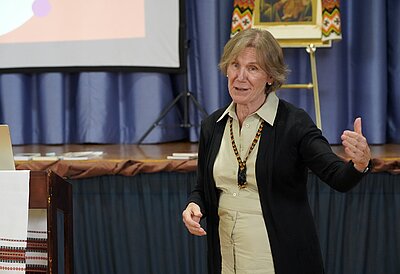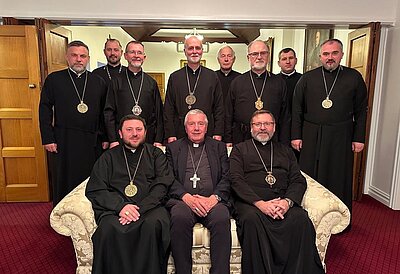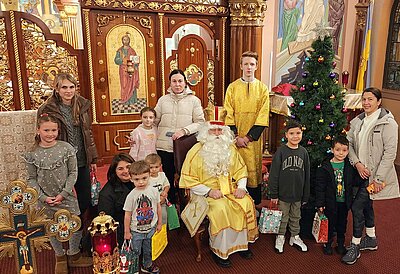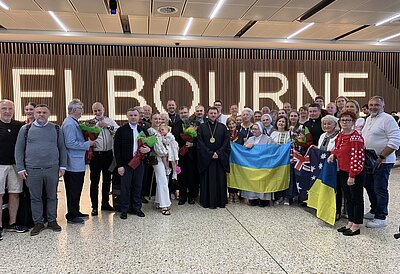- Christmas Appeal 2025
- Archeparchy
- Our faith
- Offices and ministries
- News
- Events
- Parishes
- Youth Protection
Philadelphia Archieparchial Clergy Gather in Long Branch, NJ for Annual Spiritual Retreat
Philadelphia Archieparchial Clergy Gather in Long Branch, NJ for Annual Spiritual Retreat;
Spiritual Conferences Reflect on the Life and Work of Saint Teresa of Calcutta, Mother Teresa
Long Branch, NJ—From Monday, September 17 through Thursday, September 20, the priests and deacons of the Ukrainian Catholic Archeparchy of Philadelphia gathered with Bishop Andriy Rabiy and Bishop John Bura at the San Alfonso Retreat House here for their annual spiritual retreat.
The retreat director was Rev. Brian Kolodiejchuk, Missionary of Charity Fathers.
Born in Winnipeg, Canada, Father Brian Kolodiejchuk obtained a B.A. in Philosophy from St. Michael’s College of the University of Toronto, Canada, in 1977 and his M.A. in Philosophy from the University of Manitoba, Canada, in 1981. He received a M.Div. in Theology from St. Joseph’s Seminary, Dunwoodie, New York, USA in 1985 and went on to obtain a Ph.D. in Organizational Psychology from Saybrook Institute, San Francisco, USA in 2001.
Father Kolodiejchuk’s 20-year association with Mother Teresa began in 1977 when he joined a new group of contemplative brothers she was then starting. He later joined the priestly branch of Mother Teresa’s religious family, the Missionaries of Charity Fathers, at the time of their foundation in 1984. He was ordained to the priesthood in June 1985 in the Ukrainian Catholic Church of St. John the Baptist in Newark, New Jersey, USA, by the late Metropolitan-Archbishop of Winnipeg, Maxim Hermaniuk, C.Ss.R. In March 1999 he was appointed Postulator of the Cause of Beatification and Canonization of Mother Teresa of Calcutta and had the joy of seeing her beatified on October 19, 2003. He was appointed director of the Mother Teresa Center, which is an extension of the office for the cause of canonization of Mother Teresa of Calcutta, in June 2004. He edited and wrote the commentary for the book Mother Teresa: Come Be My Light, published by Doubleday, on September 4, 2007.
Because of his total familiarity with the life of Mother Teresa, St. Teresa of Calcutta, he was able to weave her life’s work with the poor and dying into the need for clergy and all Christians to serve the poor and needy among us, becoming Matthew 25 Christians, “to satiate the thirst of Jesus.”
Mother Teresa meditated upon the words “I thirst”— taken from Jesus words from the cross on Good Friday — which became a constant reminder of the purpose of the Missionaries of Charity. “We have these words in every chapel of the MCs to remind us what an MC is here for: to quench the thirst of Jesus for souls, for love, for kindness, for compassion, for delicate love.” Ever since her call to serve the poorest of the poor in 1946, Mother Teresa insisted that the Missionaries of Charity were founded “to satiate the thirst of Jesus,” and she included this statement in the founding Rules for the new religious order: “The General End of the Missionaries of Charity is to satiate the thirst of Jesus Christ on the Cross for Love and Souls.”
During his conferences, two films, Mother Teresa and Mother Teresa: The Legacy, by Ann and Jeanette Petrie were viewed.
Mother Teresa (1986) is considered the definitive portrait of the 1979 Nobel Peace Prize winner, Mother Teresa. Shot on the run over a period of 5 years in 10 countries on 4 continents, this award winning film follows Mother Teresa into the world’s most troubled spots. From the war in Beirut to Guatemala under siege, from the devastated streets of Calcutta to the ghettoes of the South Bronx, the film is an experience of the way Mother Teresa transcends all political, religious and social barriers with her works of love.
Mother Teresa: The Legacy is the dramatic story of Mother Teresa’s last day, her sudden death and her moving state funeral which was attended by the poor, the powerful and the rich from around the world.
The clergy participated in daily liturgical services, including matins, vespers and the Divine Liturgy. Bishop Andriy Rabiy and Bishop John Bura were the main celebrants during the Divine Liturgies.
On Thursday, as is tradition, a panakhyda for all the deceased hierarchs and clergy of the Philadelphia Archeparchy was sung following the Divine Liturgy.
After the panakhyda, Bishop Andriy, on behalf of the clergy, thanked Father Kolodiejchuk, MC for serving as the retreat director and the clergy expressed their gratitude to him with the traditional singing of “God Grant Him Many Years.”
Holy Myron, which was consecrated by Patriarch Sviatoslav on Holy Thursday was distributed by Bishop Andriy to the clergy for their parishes. In symbolizing this liturgical unity under Patriarch Sviatoslav, all Ukrainian Catholic Churches throughout the world have received this Holy Myron consecrated by the Patriarch on Holy Thursday.
Often as priests absent themselves from their parishes for this time of spiritual renewal, well-intentioned parishioners may say “Enjoy your vacation” or upon return inquire “How was your vacation?’
However, a retreat is not a vacation, but a necessary and even obligatory requirement for clergy to withdraw from the daily routine of normal parish life for a time of prayer, reflection and spiritual renewal.
This concept of withdrawal for spiritual renewal can be found in the life of Jesus Christ, where the evangelists Matthew, Mark and Luke relate how Jesus, after his baptism by John, withdrew into the desert and fasted for forty days and nights.
In the 1520’s, St. Ignatius of Loyola developed his Spiritual Exercises. These spiritual exercises greatly influenced the development of retreats, especially for clergy, as a way of deepening their spiritual relationship with God.
During the time of the annual clergy retreat, as clergy remember their faithful in prayer, the faithful should also pray that the clergy have a spiritually enriching experience during their annual retreat.

